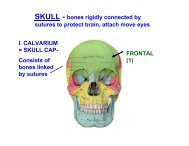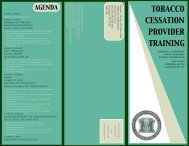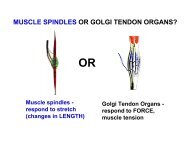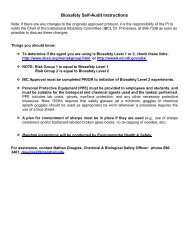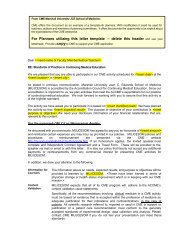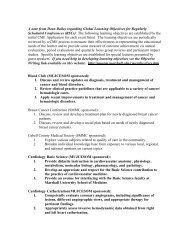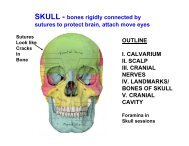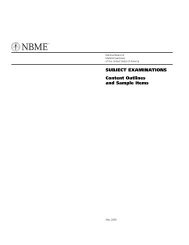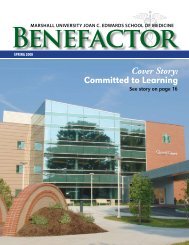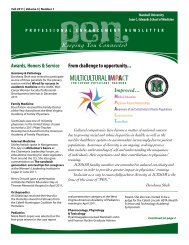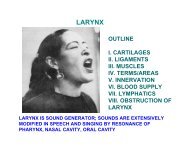FA 5 Progress Report WV-INBRE - Joan C. Edwards School of ...
FA 5 Progress Report WV-INBRE - Joan C. Edwards School of ...
FA 5 Progress Report WV-INBRE - Joan C. Edwards School of ...
- No tags were found...
Create successful ePaper yourself
Turn your PDF publications into a flip-book with our unique Google optimized e-Paper software.
Program Director/Principal Investigator (Last, First, Middle): Rankin, Gary O 30histone PTMs in <strong>of</strong>fspring can be affect by the maternal diet, mammary tissue from 130 days oldCO-CO or CA-CO groups F1 mice was isolated. The biological location <strong>of</strong> the two PTMs is to beinvestigated by Chromatin Immunoprecipitation-based Sequencing (ChIP-Seq) leading to thegeneration <strong>of</strong> epigenomic maps corresponding to the different diets. ChIP DNA was prepared asdescribed by Rada-Iglesias and colleagues (2005) using a MeCP2 ChIP compatible antibody(Abcam ab2828). The DNA fragment library was to be prepared from separate biological samplesusing the ABI SOLID System 2.0 Fragment Library Preparation protocol, and then sequenced bythe Marshall University Genomics Core Facility using the Illumina HiSeq1000 system. Oncecompleted, this should allow us to identify genes that are differentially regulated by changes inH3K18ac and H3K4me2 signal following maternal consumption <strong>of</strong> the omega-3 rich diet comparedto maternal consumption <strong>of</strong> the omega-6 rich diet.Results and Discussion: The ChIP has been performed and libraries have been prepared andsequenced in the Illumina HiSeq1000 system. We are now in the process <strong>of</strong> analyzing the resultsfrom the deep sequencing runs.NGS Project #3Title: Identification <strong>of</strong> genomic binding sites <strong>of</strong> transcriptional repressors Snail and ZEB in epithelialcells undergoing epithelial-mesenchymal transition (EMT) by ChIP-Seq.Subproject investigator: Alexey Ivanov, PhDIntroduction: Epithelial-mesenchymal transition (EMT), the generation <strong>of</strong> motile mesenchymal-likecells from epithelia, has been increasingly recognized as a major contributor to the metastaticprocess in breast as well as in many other human epithelial cancers. EMT has been associated withcancer cell acquisition <strong>of</strong> stem cell properties, increased invasion and resistance tochemotherapeutic drugs. Key inducers <strong>of</strong> EMT are developmentally regulated transcription factorsSnail and ZEB. Snail and ZEB are over-expressed in breast adenocarcinomas, and their increasedexpression is an independent prognostic factor for metastasis, poor survival and disease relapse inpatients with breast carcinoma. At the molecular level, Snail and ZEB function to repress genetranscription by binding to E-box DNA element. The role <strong>of</strong> Snail and ZEB in triggering EMT is wellestablished. However, the molecular mechanism <strong>of</strong> their action in this process is not fullyunderstood. It is unknown, for example how Snail or ZEB, being repressors, activate hundreds <strong>of</strong>genes. We have previously characterized gene expression changes in human mammary epithelialcells undergoing Snail/ZEB-induced EMT using microarrays and identified more than threethousand Snail/ZEB-regulated genes.Hypothesis: Most genes down-regulated by Snail/ZEB are likely directly bound and repressed bySnail/ZEB; while genes up-regulated by Snail/ZEB are likely indirect Snail/ZEB targets activatedthrough secondary transcriptional and post-transcriptional events.Specific Aim: We propose to identify Snail and ZEB genomic binding sites using ChIP-Seq in thesame cell culture model where we have analyzed Snail/ZEB-induced transcriptome changes andcorrelate Snail/ZEB promoter occupancy with the identified target genes.Methods: We utilized the same system <strong>of</strong> tet-inducible expression <strong>of</strong> Snail1, Snail2 or ZEB1 inHMLE cells, which we have previously used for gene expression pr<strong>of</strong>iling. Two ChIP protocols,from Dr. Peggy Farnham’s lab and from Dr. Richard Myer’s lab were compared in assayperformance. Both labs are members <strong>of</strong> the ENCODE consortium. Next generation sequencing willbe performed at the Genomics Facility <strong>of</strong> University <strong>of</strong> Southern California.Results and Discussion: It is <strong>of</strong> crucial importance to have good, ChIP-validated antibody toPHS 2590 (Rev. 06/09)Continuation Format Page



